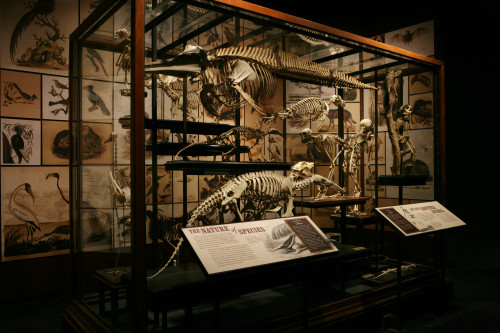
Darwin
American Museum of Natural History, New York, New York, 2005
Description
Darwin tells the story of both the life and the science of the 19th-century scientist and theoretician. It brings together artifacts and documents from throughout his life with a contemporary study of his science. The main challenge was to evoke the Victorian context of his life as well as to emphasize the continuing relevance of his science.
The graphic design focuses on the idea of “looking closely,” inspired by Darwin’s own magnifying glass, the first artifact of the exhibition. Graphics play with shifting scales, moving back and forth from macro to micro views. Large images are created of many smaller images: an orchid is composed of thousands of tiny birds, insects, reptiles and other animals; a wallpaper pattern is derived from beetles and terriers.
On the macro level, images are enlarged to the point of abstraction for case panels and wall banners. Because the photo budget was limited, these images were generated by simply scanning found objects. The London wallpaper literally disintegrates, evoking the corrosive effect of Darwin’s theories on the previously established order. Typography refers to 19th-century wood-type posters, as well as to elements of Victorian book design, with centered and curved elements and graphic flourishes.
Juror Notes
Great use of simple header and deck.
Artifact based.
Does well what exhibits are should be good at: presenting a lot of information in a clear way.
Feels contemporary; incorporates cultural elements without being corny.
Looks busy but not overwhelming. Overall, a very nice exhibit with a lot of nice bits.
Credits
- Design firm
- American Museum of Natural History
- Creative director
- David Harvey
- Art director
- Stephanie Reyer
- Designers
- Iris Jan, Rick Onorato, Dan Ownbey, Ellen Sitkin, Catharine Weese
- Photographer
- Denis Finnin
- Production coordinator
- Caroline Seitz
- Picture editor
- Vikii Wong
- Editor
- Lauri Halderman
- Writers
- Margaret Dornfeld, JoAnn Gutin, Martin Schwabacher, John Whitney
- Interactive designers
- Mike Cosaboom, Mindy Weisberger
- Project manager
- Robert Vinci
- Structural designer
- Dempsey Collins
- Architect
- Tim Nissen
- Curator
- Niles Eldredge
- Printer
- Color Edge Visuals
- Fabricators
- American Museum of Natural History, Exhibitus, SmallCorp
- Typefaces
- Tribute, Consort, Zine Sans
- Client
- American Museum of Natural History





